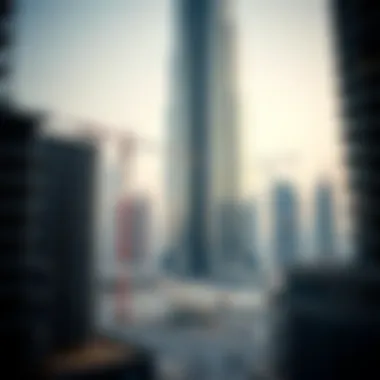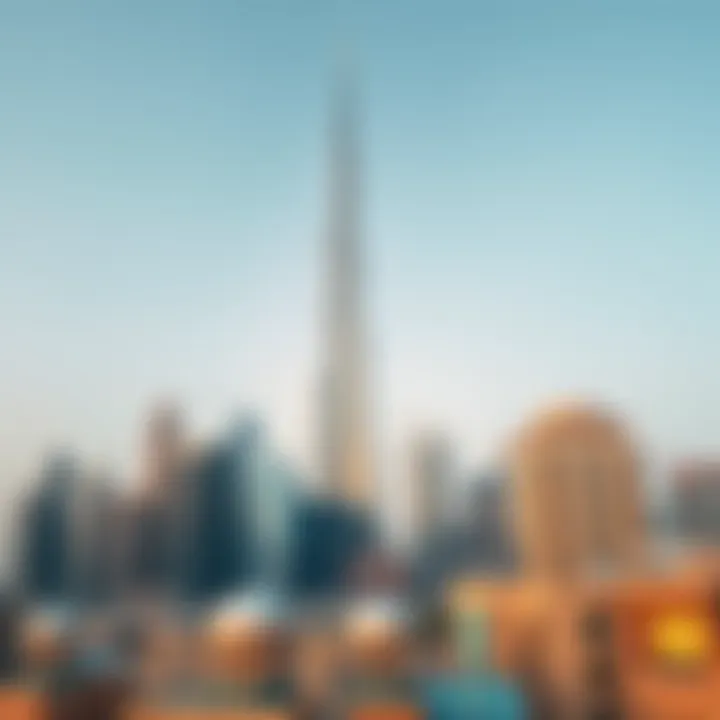Financial Insights into the Burj Khalifa Project


Intro
The Burj Khalifa stands as a monumental testament to both human engineering and the ambitious spirit of Dubai. Yet beneath its shimmering facade lies a complex web of financial maneuvering that made its existence possible. Understanding these financial undertakings offers a glimpse into not just the building itself, but also the broader implications for Dubai’s economy.
In this article, we will dissect the costs associated with the Burj Khalifa, from construction expenses to financing strategies. You will find insight into how this iconic structure has influenced the real estate market in Dubai, as well as explore current investment dynamics that potential buyers and investors face today.
Through this lens, we invite you to examine the myriad of financial choices made throughout its construction and what they might signal for the future of similar high-profile developments.
Market Insights
Current Trends
In the wake of the Burj Khalifa's completion in 2010, the property market in Dubai has undergone a monumental transformation. The tower has not only risen to become an architectural marvel but also a symbol of luxury and wealth, attracting international investors, expatriates, and tourists alike. With the global economy fluctuating, there’s been a noticeable demand shift in Dubai’s real estate sector.
Currently, there’s a significant trend towards urban living, with properties near iconic landmarks like the Burj Khalifa commanding high prices. The proximity to retail, dining, and entertainment options makes these areas prime for investment, yielding substantial returns.
Price Analysis
When dissecting the financial intricacies surrounding the Burj Khalifa, it’s essential to scrutinize pricing strategies. The costs associated with this marvel were staggering, reportedly around $1.5 billion. This huge sum encompassed everything from materials—thousands of tons of steel and glass—to labor costs.
- Construction Costs:
Rising labor rates and top-tier materials made constructing this skyscraper an expensive affair. However, the initial investment was justified through the luxury residential and commercial units sold within. - Land Prices:
The real estate surrounding the Burj is some of the most expensive in the world. For instance, adjacent properties are facing escalating prices due to the prestige of living near the tallest building on the planet.
"The Burj Khalifa has catalyzed an unprecedented wave of investment in the UAE real estate market and continues to shape trends in urban development."
Asset appreciation has led to increased interest from both local and foreign investors who view properties in this lucrative area as a goldmine.
As we look into Investment Strategies, understanding the market climate becomes crucial for prospective buyers as they weigh the options between purchasing or renting properties in this prestigious vicinity.
Prolusion to Burj Khalifa's Construction Costs
Understanding the construction costs associated with the Burj Khalifa opens a window into the financial landscape that underpins one of the most remarkable feats in modern architecture. This skyscraper, soaring majestically at 828 meters, isn't merely a structure; it represents an ambitious vision and a multifaceted financial undertaking. Knowing the financial elements involved—such as construction expenses, labor costs, and the strategic planning required—can provide invaluable insights, particularly for investors, buyers, agents, and developers deeply woven into the fabric of Dubai's bustling real estate market.
Construction costs encapsulate more than just the bottom line; they reflect the economic realities of a rapidly developing region, the innovative spirit behind groundbreaking design, and the intricate dance of funding and spending. Including an analysis of historical context and architectural ambition adds richness to this exploration, allowing readers to appreciate the true worth of what’s standing tall in the Dubai skyline.
This section sets the stage for a deeper dive into how such considerable investments shape not only the physical space but also the very fabric of Dubai's economy. By dissecting costs, exploring funding avenues, and examining implications for all stakeholders involved, the narrative surrounding the Burj Khalifa emerges as a compelling case study in modern construction economics.
Historical Context
The Burj Khalifa’s financial story is intricately tied to its historical context. Initiated in the early 2000s, as the world was emerging from a dot-com bubble and seeking new avenues for investment, Dubai saw an opportunity to showcase its ambitions through grandeur. The decision to build the world’s tallest structure was not merely a local endeavor; it was a statement echoing across global financial markets.
In examining the backdrop, one can notice how investment surged during this period, bolstered by speculative confidence in the region’s rapid urban development. With the UAE’s economy on an upswing, fueled by oil prices, the project aligned perfectly with the nation’s broader vision of diversification—a push to establish Dubai as a tourism and business hub. This historical alignment propelled the project further, fostering both investor interest and global media attention, laying the groundwork for funding strategies employed throughout its construction.
Architectural Ambitions
The architectural ambitions behind the Burj Khalifa offered a perfect intertwining of grandeur and functionality, leading to costs that encompassed everything from design to operational sustainability. Designed by the renowned firm Skidmore, Owings & Merrill, the Burj Khalifa was imagined not just as a series of floors stacked upwards, but as a blend of art and engineering capacity where style meets safety. This design dream translated directly into the financial aspect, as creating such a towering edifice necessitated advanced materials and technologies.
The choice of cutting-edge glass to reflect the sunlight, the complex mechanical systems for temperature regulation, and the inner workings that align with the principles of sustainable architecture are just a few factors contributing to soaring costs. These decisions underscore the ambition behind the Burj Khalifa; it’s about more than just height—it's about setting a benchmark for future skyscrapers globally.
In turn, the drive for innovation required careful, yet bold, financial pledges from stakeholders, reinforcing the reality that throwing money at design doesn’t always guarantee success. Rather, it takes an astute understanding of architectural ambition balanced with practical and economic realities. As we venture further into the financial specifics, understanding these ambitions offers a lens into how every penny spent works toward a broader visionary goal.
Total Estimated Cost of Burj Khalifa
Understanding the total estimated cost of the Burj Khalifa is crucial because it lays the groundwork for comprehending all financial aspects related to this architectural marvel. The staggering figures involved not only reflect the vision behind this building but also the economic dynamics at play in Dubai. By evaluating the cost components, one can glean insights into the financial strategies employed to turn a lofty dream into a reality. This knowledge serves as a pivotal reference point for investors, buyers, and developers, shedding light on the complexities and risks associated with similar future projects.
Breakdown of Major Costs
Construction Expenses


The construction expenses for the Burj Khalifa are one of the most significant factors contributing to its overall cost. These expenses account for a large chunk, roughly around 60 percent of the total financial outlay. Given the scale of the building and the materials used, it’s no surprise that this was the largest expenditure. High-quality resources, such as the unique concrete, were essential to achieving the desired height and stability. While construction expenses are a common concern in all large-scale projects, the Burj Khalifa’s sheer height and design complexity pushed these costs to new heights—both literally and metaphorically.
A distinct characteristic of construction expenses in this case is the use of innovative engineering solutions. This approach not only helps in managing costs but enhances the structure's safety and durability.
Land Acquisition
Land acquisition presented its own set of challenges and costs. Acquiring prime real estate in Dubai, especially a plot suitable for a building aiming to be the tallest in the world, added a hefty bill to the overall project. This process was not merely about securing a location; there were extensive negotiations and assessments involved, which can elongate timelines and increase pricing.
Furthermore, the unique feature of this land acquisition lies in its strategic location, ensuring that the Burj Khalifa captures the essence of Dubai’s skyline. While the costs were high, the long-term benefits proved invaluable, particularly in terms of increased tourism and subsequent commercial developments around the site.
Design and Engineering Fees
Design and engineering fees were another significant element in the overall financial landscape of the Burj Khalifa. Engaging with world-class architects and engineers added a premium price tag to the project. This aspect of the costs is crucial because it not only reflects the design's aesthetics but the engineering innovations that made a structure of this magnitude possible.
A key characteristic of these fees is the collaborative nature of design and engineering. The unique challenges posed by the skyscraper's height and searing winds required bespoke solutions that pushed the boundaries of standard engineering practices.
Although these fees appear excessive, they are often justified as they pave the way for groundbreaking architectural achievements.
Finishing Costs
Finishing costs rounded off the overall expenditures associated with the Burj Khalifa. This comprises everything from upscale interiors to state-of-the-art installations. The focus here is not just on aesthetics but also on functionality and luxury. The finishing stage is where the vision of the architects really comes to life—merging style with comfort and usability.
A standout aspect of these costs is the meticulous attention to detail that forms part of the project. High-end materials and advanced technologies were used, pushing the final figure even higher. However, these aesthetic choices enhance the building’s appeal, consequently justifying the expenses in terms of potential returns from commercial activities.
Comparison with Other Skyscrapers
When juxtaposing the total estimated cost of the Burj Khalifa with other notable skyscrapers, it becomes evident that scalability, ambition, and economic context play pivotal roles. Other towers, like the Shanghai Tower or One World Trade Center, have demonstrated varied financial strategies and resultant costs which reflect their local economies and purposes.
Using comparative analysis encourages a thorough understanding of where the Burj Khalifa stands in relation to global skyscraper trends. Investors and developers can draw lessons from the experience of Burj Khalifa as they venture into future skyscraper projects, whether in Dubai or beyond.
Funding the Project
When discussing the monumental task of erecting the Burj Khalifa, understanding how it was financed is crucial. The financial framework behind the project not only serves as a roadmap for similar future constructions but also showcases the intricate web of partnerships and investments needed to bring such a behemoth to life.
The funding aspects highlight various elements, including who stepped in to bear the heavy costs, the risks involved, and how financial backing can catalyze architectural ingenuity. The Burj Khalifa, with its staggering height, became a symbol of architectural ambition but, at the same time, posed significant financial challenges that required a diverse strategy to overcome.
Sponsorship and Investment Sources
In funding the Burj Khalifa, a multitude of sponsors and investors came together, each playing a pivotal role in its financial ecosystem. Prominent among them were investment groups, private shareholders, and sovereign wealth funds. Notably, Emaar Properties, as the primary developer, invested a considerable chunk of the initial capital. Their innovative approaches and faith in the project were instrumental in attracting further investments.
Major financial institutions, including the Abu Dhabi Investment Authority, jumped on board, recognizing the potential for lucrative returns. The allure of such an iconic structure drew numerous global investors, looking to tie their fortunes to a world-class icon. Another noteworthy mention is the strategic partnerships formed with international construction firms, which not only contributed capital but also expertise.
By pooling financial resources from various sectors, the project was able to weather the storms of unforeseen costs and delays. It's a lesson in collaboration, emphasizing how multifaceted financial sources can create a robust support system for ambitious projects.
Role of the Dubai Government
The Dubai Government played an essential part, serving as both a facilitator and a major contributor to the financial backing of the Burj Khalifa. Their commitment stemmed from a vision to position Dubai not just as a regional hub but as a leading global destination for tourism and business.
This supportive role was manifested in the form of initial seed funding and favorable policies. The government’s investment underscored its reliance on the Burj as a catalyst for economic growth and urban development. By injecting substantial resources into the project, the government ensured that the Burj Khalifa would not just be some tower but a beacon of progress that symbolizes Dubai's ascent on the world stage.
Furthermore, the government facilitated tax incentives that made the project more appealing to private investors. This strategy effectively lowered barriers for investment and helped create a thriving environment for stakeholders. As such, the Burj Khalifa became not only a landmark in terms of architecture but also in financial strategy—exemplifying how public-private partnerships can yield remarkable results for urban development.
"The Burj Khalifa is not just a building; it's a testament to visionary thinking and collaborative financing."
Economic Implications of the Burj Khalifa
The construction of the Burj Khalifa is not just about creating a towering structure; it has multifaceted economic implications for Dubai and beyond. The Burj Khalifa stands as a beacon of architectural prowess and a catalyst for economic growth. This section examines how the world's tallest building has significantly influenced tourism, the real estate market, and overall economic dynamics within Dubai.
Boosting Tourism


Tourism is one of the most visible impacts of the Burj Khalifa. Visitors flock from all corners of the globe, drawn by the lure of standing atop this magnificent skyscraper, which offers stunning panoramic views of Dubai. The Burj Khalifa’s observation deck, located on the 148th floor, has become a key attraction contributing to the surge in tourist footfall. According to recent estimates, millions of tourists visit annually, with many willing to pay premium prices for the experience.
The economic benefits of this tourism boom are tangible. Local businesses, from hotels to restaurants, have witnessed a spike in profits directly attributable to the influx of visitors. As an iconic landmark, the Burj Khalifa has reinforced Dubai’s brand as a premier tourist destination. Increased foot traffic around the area can be seen in the bustling shops and entertainment venues that have sprouted nearby, creating jobs and stimulating local economies.
Impact on Local Real Estate Market
The Burj Khalifa’s symbolic stature extends into the local real estate market, impacting property values and commercial developments in the vicinity significantly.
Property Value Appreciation
Property value appreciation has been a significant outcome of the Burj Khalifa's presence. The allure of living or investing near this iconic structure has drawn both local and international buyers. Properties around the Burj Khalifa have seen a rise in demand, which often leads to increased prices. Investors and expatriates recognize the potential for long-term returns in real estate near such a landmark.
The key characteristic of property value appreciation in this context is that it isn't merely about rising prices; it’s also about the enhanced desirability of the area. The Burj Khalifa acts as a symbol of prestige, making it a magnet for investors eager to tap into the vibrancy of Dubai's real estate sector.
However, there are challenges as well. The rapid increase in housing prices can make it difficult for some residents to afford living close to such a popular area, which can lead to a disparity in property ownership.
Commercial Development
Commercial development, driven by the Burj Khalifa, is another crucial aspect of its economic impact. The skyscraper has catalyzed a wave of commercial projects, including hotels, malls, and entertainment complexes, all designed to serve the increasing number of visitors and residents around the area.
The key characteristic of this commercial development lies in the unique blend of luxury and accessibility. Businesses set their sights on creating offerings that match the expectations of both tourists and locals, often combining high-end retail with casual dining options. This mix aims to create a vibrant atmosphere, attracting foot traffic and revenue generation.
However, such extensive development comes with its own set of challenges, such as urban overpopulation and infrastructure strain. Balancing growth while ensuring sustainable practices will be pivotal in the coming years as the area continues to thrive.
"The Burj Khalifa isn't just a building; it's a financial powerhouse that has reshaped Dubai’s economic landscape."
In summary, the economic implications of the Burj Khalifa are profound. From boosting tourism to elevating property values and enabling extensive commercial developments, its impact is a testament to how ambition can reshape a city's economic fabric. As we transition to discussing cost overruns and challenges, it becomes clear that such grand projects always come with their unique set of hurdles.
Cost Overruns and Financial Challenges
The financial discourse surrounding the Burj Khalifa is not complete without examining the significant topic of cost overruns and the myriad challenges encountered along the way. For such a monumental project, the path has not been without its financial pitfalls. Understanding these elements is crucial not only for grasping the cost-effective strategies that inform current and future architectural endeavors but also for recognizing the broader implications of financial mismanagement in major constructions.
Cost overruns can derail a project, causing a ripple effect that impacts financing, cash flow, and investor confidence. As we delve into this realm, we see that mitigating these challenges requires a combination of strategic foresight, opportunistic thinking, and sometimes even sheer resourcefulness.
Factors Leading to Overbudgeting
Several key factors contributed to the financial strain witnessed during the Burj Khalifa’s construction.
- Unexpected Ground Conditions: The foundation was initially planned lower than what was actualized. When the construction team struck a patch of hard rock that required additional dynamiting and labor, costs soared.
- Fluctuations in Material Prices: As construction progressed, the global market experienced significant volatility that pushed material costs beyond initial estimates. Steel prices, for instance, can vary widely and impact the overall budget considerably.
- Project Scope Changes: Midway through, the ambition behind the Burj Khalifa’s design prompted enhancements like additional luxury fittings and features, which were not part of the original scope and led to further expenses.
While these factors seem typical in large-scale construction, they illustrate how interconnected the financial undertakings can be.
"The story of the Burj Khalifa is as much about its height as it is about the myriad financial hurdles it leapt over."
Management Strategies Adopted
In response to the financial challenges presented, a variety of management strategies were put in place to steer the project back on course.
- Contingency Planning: From the outset, a contingency fund was established, which allowed the project to absorb some costs caused by unexpected changes without derailing timelines or quality.
- Value Engineering: This included a thorough review of the building methods and materials to identify more affordable options that wouldn’t compromise quality. This method is particularly pivotal in high-stakes projects where every dollar counts.
- Regular Audits and Adjustments: Engaging in frequent financial assessments allowed project managers to stay ahead of budget changes and manage stakeholder expectations effectively.
By implementing these strategies, the management aimed to not only navigate through the turbulent waters of financial challenges but also ensure the successful completion of one of the most ambitious architectural feats in modern history.
Sustainability Considerations
Sustainability in large-scale construction projects, especially ones as ambitious as the Burj Khalifa, is not merely an afterthought. Instead, it forms a crucial cornerstone in planning, funding, and operational phases. The Burj Khalifa, standing tall as the world’s tallest building, has crafted not just a skyline but a narrative around sustainability endeavors that resonate throughout the construction sector. This element of sustainability touches on various aspects, from environmental implications to long-term financial impacts — ensuring the structure is both a marvel and a responsible investment.
Financial Benefits of Sustainable Practices
Understanding the financial benefits that stem from sustainable practices in the construction of the Burj Khalifa is key. Players in the construction game have seen sustainable methods soften expenses while boosting the overall appeal of the project. Key benefits include:


- Reduced Operational Costs: Energy-efficient systems lead to lower utility bills. About 30 percent of the building's energy needs come from renewable sources, which resulted in significant savings.
- Increased Property Value: Buildings that uphold sustainability standards often appreciate faster than traditional counterparts. Buyers are increasingly prioritizing eco-friendly features, making facilities such as the Burj Khalifa highly sought after.
- Government Incentives: Financial backing through tax credits and grants for sustainable initiatives can offset initial investments. Many investors viewed the Burj Khalifa favorably because of these potential financial perks.
“Investing in sustainable practices is like planting a seed; the rewards grow and blossom over time.”
These financial benefits highlight the intrinsic value of sustainability, leading to a more robust financial model in normally volatile construction environments.
Sustainability in Design and Operations
In the context of the Burj Khalifa, sustainability is embedded at every juncture, from design to daily operations. The architect and developers focused on creating a structure that would not only look stunning but also reduce its environmental footprint. Key features include:
- Use of Recycled Materials: The construction utilized a significant proportion of recycled materials. This not only reduced the demand for new resources but also lessened waste.
- Innovative Water Management Systems: Equipped with a greywater recycling system, the Burj uses processed wastewater for irrigation and other non-potable applications, reflecting a commitment to resource conservation.
- Advanced HVAC Systems: To ensure comfort while maintaining efficiency, state-of-the-art HVAC systems were integrated, achieving energy savings and enhancing air quality within the building.
By knitting these sustainability-focused elements into its operations, the Burj Khalifa serves as a leading example that inspires future projects, proving that a blend of luxury and eco-friendliness is attainable without compromising aesthetic or structural integrity.
For more insights on sustainable practices in architecture, you may visit resources such as Britannica, and for regular updates in real estate trends, check Reddit.
Ultimately, the takeaways from such monumental endeavors as the Burj Khalifa can catalyze changes in building practices globally, encouraging a shift towards sustainability that prioritizes both the environment and profitability.
Future Prospects and Long-term Viability
The future prospects and long-term viability of the Burj Khalifa are pivotal to understanding its sustained impact on the urban landscape of Dubai and beyond. As one of the tallest structures in the world, the Burj Khalifa has become a symbol of opulence and ambition, attracting tourists and investors alike. Its towering presence is more than just a visual marvel; it embodies the economic strategies that might shape future developments in the region.
Anticipated Influence on New Developments
As new skyscrapers and commercial projects spring up in Dubai and throughout the Middle East, the Burj Khalifa sets a precedent. This landmark serves not only as a benchmark for height but also for design innovation and workflow optimization. Developers looking to capitalize on its reputation could draw inspiration from its engineering feats and luxurious amenities, pushing them to elevate their projects in similar directions.
Moreover, new developments are often designed with the Burj Khalifa's principles in mind:
- Utilization of cutting-edge technology: Creating energy-efficient buildings that respond to the needs of a changing climate is crucial.
- Integrated community spaces: Planning considerations now often include public areas that invite interaction, mirroring the social nature of the Burj Khalifa's surrounding vicinity.
- Tourism-centric features: Inspired by the crowds drawn to the Burj Khalifa, new projects are likely to offer attractions or experiences that encourage foot traffic and spending.
The Burj Khalifa's influence stretches beyond its confines, shaping building codes, architectural styles, and financing strategies used for future constructions.
Investment Opportunities Arising from Burj Khalifa
The Burj Khalifa has created a ripple effect in the investment landscape of Dubai. Real estate investors are keenly aware that properties close to the Burj Khalifa are generally perceived as premium investments. The immediate area has experienced heightened property values, with investors often banking on the 'burgeoning brand' the tower has fostered.
Untapped investment opportunities include:
- Commercial Spaces: Retail and office spaces in the vicinity continually garner interest; proximity to the Burj Khalifa promises heightened visibility and foot traffic.
- Tourism Ventures: With visitor numbers consistently in the millions, businesses that cater to tourists can thrive, whether in hospitality, dining, or experiences.
- Mixed-Use Developments: New projects integrating residential living, workspaces, and leisure options present diverse investment methods aligned with contemporary urban living trends.
Potential investors should note that careful market analysis and strategic positioning are crucial for maximizing advantages offered by the Burj Khalifa's remarkable presence. The long-term viability hinges on the ability to adapt and innovate, ensuring that new developments not only mirror the grandeur of the Burj Khalifa but also contribute to a dynamic and evolving market.
Finale
The financial journey of the Burj Khalifa extends far beyond the impressive heights of its architecture. Throughout this article, we have explored the multifaceted financial undertakings behind this monumental skyscraper.
Understanding the financial implications of such an ambitious project is crucial for various stakeholders, including investors, developers, expatriates, and real estate agents.
**Key Elements:
**1. Construction Costs and Funding:
- The total estimated construction costs, including major expenses such as design and engineering fees, were staggering. Funding the project required creative strategies, blending private investment with support from the Dubai government.
- Economic Implications:
- Sustainability Considerations:
- Future Prospects:
- Burj Khalifa's influence on tourism and the local real estate market has been profound. Its establishment has not only boosted property values but also catalyzed commercial development within the vicinity.
- The financial benefits of incorporating sustainable practices into the Burj Khalifa underline the importance of investing in green technology. This benefits stakeholders and enhances the building's long-term viability.
- The building has set a precedent for future developments, inspiring ambitious projects and attracting investment opportunities. The value of such a landmark cannot be overstated, as it reiterates Dubai's commitment to innovation and growth.
In wrapping up, this expansive examination of the Burj Khalifa encapsulates a financial narrative that resonates with both history and modern-day economic strategies. Investors and stakeholders can glean insight not only from the specific figures discussed but also from the broader implications of undertaking such a grand project in an increasingly competitive global market. The case of Burj Khalifa serves as an educational cornerstone, offering lessons in investment, project management, and sustainable urban development.
"The Burj Khalifa is not just a building; it is a symbol of ambition, a testament to economic resilience and innovation."
For further insight, consider exploring resources like Britannica and Wikipedia for a comprehensive view of this iconic structure's history and its ongoing financial impact.







